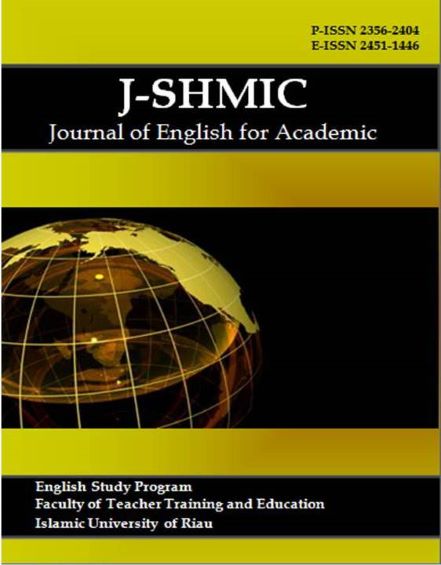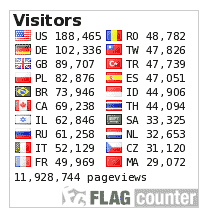The Correlation between Morphological Awareness and Vocabulary Mastery of The Fifth Semester Students of English Department of FKIP Universitas Riau
Keywords:
Morphological Awareness, vocabulary masteriAbstract
This research changed into meant to discover the. Correlation. between morphological. awareness. and. vocabulary., mastery. of the 5th semester. Students. of English, Department. of FKIP Universitas Riau. In this research, the research design was correlational design. Correlational is the types in. quantitative approach and the research, population was the, fifth semester. Students. of .English .Department of FKIP Universitas Riau. There are 39 students.from the 5th semester of English Department of FKIP Universitas Riau were selected and the sample was taken by using cluster random, sampling. The research instruments, of this study were morphological awareness test and vocabulary level, test. The data showed that 59.84 of frequency distribution mean score of morphological awareness were moderate level and 71.61 of frequency distribution mean score of vocabulary mastery were high vocabulary level. Additionally, the correlation coefficient was 0.601, which was on a scale from 0.00 - 1.00. The findings of this study indicated a positive, correlation between, two variables. According to this result, the correlation, between students' morphological, awareness and, their, vocabulary, mastery was classified as strong correlation. To facilitate students' understanding of the correlation, between, morphological awareness and vocabulary mastery, this, research would analyze the correlation between the two.
Downloads
References
Adam. (2018). Relationship between Morphological Awareness and Vocabulary Mastery. Anglo-Saxon, 9(1), 24–31.
Anisa, I. (2016). The Vocabulary Mastery of the second Semester Students of Widya Dharma University in academic Year 2015/2016. Magistra, 98, 60–70.
Creswell, J. W. (2012). Planning, Conducting, and Evaluating Quantitative and Qualitative Research.
Delfi, S., & Yamat, H. (2017). an Analysis of Studies on Teaching and Learning. J-SHMIC : Journal of English for Academic, 4, 101–115. https://journal.uir.ac.id/index.php/jshmic/article/download/703/388
EF Education First. (2020). English Proviency Index. Ef Epi, 1–27.
Emelia Agustianti, Delfi, S., & Dahnilsyah, D. (2021). The Correlation between University Students’ Vocabulary Learning Strategies and The Vocabulary Mastery Level. J-SHMIC : Journal of English for Academic, 8(2), 153–167. https://doi.org/10.25299/jshmic.2021.vol8(2).7392
Farsi, B. Al. (2008). Morphological awareness and its relationship to vocabulary knowledge and morphological complexity among Omani EFL university students. Unpublished Master‟ s Thesis, University of Queensland, 3(6), 94. http://www.asian-efl-journal.com/Thesis/Thesis-Al-Farsi.pdf?origin=publication_detail
Gay, L. R., Mills, G. E., & Airasian, P. (2012). EDUCATIONAL RESEARCH.
Hafizh Ana Nafiah. (2017). The Correlation between Students’ Morphological Awareness pf Affixes to Their Reading Comprehension. 210093.
Ibrahim Rabadi, R. (2019). Morphological Awareness and Vocabulary Knowledge among English Language Learners. Arab World English Journal, 10(3), 43–63. https://doi.org/10.24093/awej/vol10no3.4
Khairumi, N., Delfi, S., Program, E. S., Training, T., Faculty, E., & Riau, U. (2020). Second-Year Students of English Study Program. 7, 1–8.
Khairunnisa, N., Delfi, S., & Supriusman. (2019). 25059-48629-1-SM (7).pdf. J-SHMIC : Journal of English for Academic, 4.
McBride-Chang, C., Wagner, R. K., Muse, A., Chow, B. W. Y., & Shu, H. (2005). The role of morphological awareness in children’s vocabulary acquisition in English. Applied Psycholinguistics, 26(3), 415–435. https://doi.org/10.1017/S014271640505023X
Nation, P. (2001). Teaching Vocabulary. The Modern Language Journal, 53(8), 531–537. https://doi.org/10.1111/j.1540-4781.1969.tb04998.x
Ngoc Yen Dang, & Webb, S. (2016). Chapter 15: Making an essential word list for beginners. Making and Using Word Lists for Language Learning and Testing, 153–167. https://doi.org/10.1075/z.208.15ch15
Novawan, A., Aisyiyah, S., Miqawati, A. H., Wijayanti, F., & Indrastana, N. S. (2020). JER| Journal of ELT Research. 5(1), 80–93. https://doi.org/10.22236/JER
Renandya, W. A., Hamied, F. A., & Nurkamto, J. (2018). The Journal of Asia TEFL English Language Proficiency in Indonesia: Issues and Prospects 1). The Journal of Asia Tefl, 15(3), 618–629. http://dx.doi.org/10.18823/asiatefl.2018.15.3.4.618
Webb, S., Sasao, Y., & Ballance, O. (2017). The updated Vocabulary Levels Test. ITL - International Journal of Applied Linguistics, 168(1), 33–69. https://doi.org/10.1075/itl.168.1.02web
Published
How to Cite
Issue
Section
This is an open-access article distributed under the terms of the Creative Commons Attribution-ShareAlike 4.0 International License which permits unrestricted use, distribution, and reproduction in any medium. Users are allowed to read, download, copy, distribute, search, or link to full-text articles in this journal without asking by giving appropriate credit, providing a link to the license, and indicating if changes were made. All of the remixes, transform, or build upon the material must distribute the contributions under the same license as the original.











